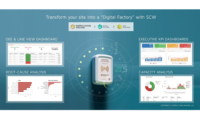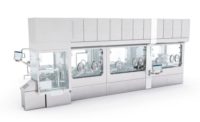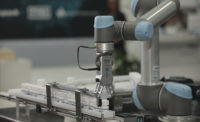Cover Story: Case Study
Nephron Pharmaceuticals adopts new packaging lines
Secondary packaging line takes products from the filling system to the pallet, from a single source.

Sterilization cassette loading. Photo: Schubert-Pharma

Four-axis robots handle the products, while enabling future product sizes to be processed without requiring significant format adjustments. Photo: Schubert-Pharma

The BFS blocks are removed from the sterilization cassettes in rows and placed directly into the separating station. Photo: Schubert-Pharma

The shearing motion of the separating tool separates vials from the blocks. Photo: Schubert-Pharma




Nephron Pharmaceuticals Corporation is a global leader in manufacturing generic respiratory medications and a pharmaceutical contract manufacturer. Nephron is headquartered in Orlando, FL and manufactures all its pharmaceuticals in the U.S. For a new production facility in South Carolina, Nephron was on the lookout for a supplier and service provider for secondary packaging line processing – taking products from the filling system to the pallet – and ideally, coordinated from a single source.
In the new facility, Nephron planned to package what would be an entirely new product for the company: an injection agent to be filled in a new type of vial – using polypropylene for the first time, instead of polyethylene. Nephron didn’t yet have any direct experience in handling this product in the secondary packaging system. Furthermore, the products had to be sterilized in an autoclave – another process step with which the company wasn’t familiar. And finally, the products would have to be fitted with a shrink-wrap sleeve prior to packing, instead of a labeled pouch or a separate label, like other Nephron products.
For these reasons, the new partner’s expertise in engineering consulting and project management would play a key role. The company opted for Schubert-Pharma (schubert-pharma.de), the team of pharmaceutical packaging specialists from Gerhard Schubert GmbH and IPS GmbH (International Packaging Systems) based in Crailsheim, Germany.
Schubert-Pharma delivered two packaging lines to Nephron, each one comprising of four individual machines – a TLM tray loader, a TLM vial separater, a TLM cartoner and a Schubert TLM case packer. All functional components are based on the TLM modular system, which once again succeeded at proving its high-level performance.
Packaging and sterilization
Following the filling process in the primary machine, the packaging process begins with the TLM machine taking over the blow-fill-seal blocks (BFS) and sorting them in sterilization cassettes, which are then grouped on a sterilization pallet. A TLM-P4 depalletizing/palletizing robot puts the cassettes in place. TLM-F4 four-axis robots can easily take on product handling, while also enabling future product sizes to be processed without requiring complex format adjustments. Both picking up the products by robot and providing the completed pallets for autoclaving take place in a way that is laser-supported and fully automatic. That is why this step – like virtually the entire packing process – does not require manual intervention.
For the actual sterilization, the cassettes spend 20 minutes in the autoclave chamber, where any microbials are killed at temperatures close to 248 degrees Fahrenheit. After sterilization, the products are separated as they are removed from the sterilization cassettes. For this purpose, the existing blocks of four must be separated so that individual BFS vials can be made available. While competitive machines ‘mechanically split’ the blocks of four, this step is positively controlled in the TLM product splitter using molded change parts and is therefore extremely gentle on the product. The BFS blocks are removed from the cassettes row by row and placed directly into the separating station. Through a shearing motion, the separating tool separates the block into individual BFS vials.
Once the product blocks are separated, the individual BFS vials are inserted into product carriers or pucks. A special feature in this process step is that the products are deposited into the pucks headfirst. A sensor checks that the cassettes have been completely emptied and then they are palletized for reuse. A complete batch from the autoclave can be handled in the staging area where the pallets come and go. In two intermediate downstream steps, the products are checked for proper sealing (vacuum check) and then labeled with a shrink-wrap sleeve.
Cartoning and delivery to the case packer
The next step is cartoning the vials. To this end, the product needs to be removed from the puck and grouped in the appropriate count for the intended carton sizes. The TLM top-load cartoner is the ideal solution for cartoning ‘standing’ vials with different heights and numbers in the carton. The TLM machine covers a wide range of formats and enables trouble-free adaptation, even to future carton sizes.
In a “handshake” process, the products are removed from the pucks and passed on to a second TLM-F2 robot. During the transfer, the products are swiveled 180 degrees and passed to the loading robot in the desired orientation. The robot pitches the product row into the desired number of vials per row in the carton. Once a package insert has been included and the carton has been closed, the carton is then passed on to the last TLM machine, the case packer where product cartons are placed in a FEFCO corrugate shipping case. Finally, the completed shipping carton is transferred to the central pallet, which transports the cartons to the warehouse.
A packaging speed of nine million vials per machine per month is anticipated, corresponding to 530 vials per minute for both carton and vial formats. Only five workers are required on the line and they are primarily responsible for quality inspection.
The line management system and track & trace functionality
With increasingly stringent regulatory requirements with regard to serialization, Schubert-Pharma also developed an implementation concept for an intelligent line management system with integrated track & trace functionality for Nephron. Schubert-Pharma first adapted Nephron’s interfaces in their factory-wide data management system (Manufacturing Information System, MIS) and then developed the required software. The system receives randomized serial data for the product carton from the MIS, groups them together in the shipping carton and communicates it back to the MIS at the production location.
“We are more than satisfied with the line and with Schubert-Pharma’s project management,” says Jonathan Burgess, R&D engineer at Nephron Pharmaceuticals in Orlando. “It was especially important for us to have a permanent contact person at Schubert and to remain in touch through the entire process. The products, as well as individual process steps, such as sterilization, were new to us. We wanted an expert advisor throughout the entire process to guide us in selecting individual components. Schubert-Pharma took on this role brilliantly. The main reason we chose Schubert-Pharma, however, was that we would be able to build the entire secondary packaging line using the TLM modular system’s seven basic components, which had already proven themselves in several other projects.”
Looking for a reprint of this article?
From high-res PDFs to custom plaques, order your copy today!










